关系基本上是请求集的集合或组合。排列的对,通常称为点。关系是一组输入和输出值对,以有序对的形式显示。
它是数据集之间的相互关系。
关系=(输入值,输出值)
Consider this example of a relation: The relationship between favorite colors of students and their names.
(x, y) = (student’s name, favorite color)
Set A = {(Pink, Marry), (Green, Ron), (Red, Steve), (Red, Paul), (Pink, Daemon)}
仔细注意该设置,多个学生都喜欢相同的颜色。因此,它们还允许一个输入值具有多个对应的输出值。
函数
函数是一组安排的对,其中每个输入组件只有一个与之相关的输出组件。
关系的先前示例不是函数,因为一个以上的学生喜欢相同的颜色。
由于同一个输入与多个输出相关联,因此它不能是一个函数。
Note: A function may have two input values assigned to the same output value but can NOT have two output values assigned to the same input value.
| IS A FUNCTION | NOT A FUNCTION |
|
{ (1,5) , (4,5) } |
{ (5,1) , (5,4) } |

间隔及其表示法
间隔是要在数字行上显示的子集。
示例: 1和6范围内的所有实数都是一个区间,例如2.5、3、4.567,依此类推,直到6。
我们在间隔中包括1和6吗?
间隔符号是一种组成实数线子集的方法。
示例: (0,20],[1,2],(4,7),[4,8),[-3,0]。
间隔类型
在数字行上有两种时间间隔:
- 开门间隔
- 封闭间隔
开放时间间隔不包括终点。 ()括号表示打开间隔。
示例: (4,6),(6,9),(-3,2)
封闭间隔包括集合中的端点。用[]括号表示。
示例: [3,5],[-4、0],[6、9]
Example – Set A= {x : -4 < x <= 5 }. Here 4 is not included in the set but 5 is included as x.
So, the set is represented as x = (-4,5].
域和范围
域–关系或函数中涉及的所有值都称为域。
范围–从关系或函数中出现的所有实体(输出)都称为范围。
使用的所有输入值(独立值)形成域集。
使用的所有输出值(从属值)形成范围集。
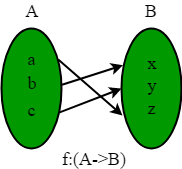
示例:给定函数:-f = 2x + 1,如果1 <= x <= 5,则找到域,范围。
解决方案:
The values of x lies from 1 to 10.
So, domain is {1, 2, 3, 4, 5}.
The values of f obtained by putting domain elements in the function will be range.
So, if x=1 then f = 2(1)+1 = 3,
if x=2 then f = 2(2)+1 = 5,
if x=3 then f = 2(3)+1 =7,
if x=4 then f = 2(4)+1 = 9,
if x=5 then f = 2(5)+1 = 11.
So, range is {3,5,7,9,11}.
示例:给定函数:-F = x 2 -5,找到域,范围?
解决方案:
The value of x is squared and then 5 is subtracted by 5. Any real number can be squared and 5 can be subtracted from it, so there are no restrictions on the domain of this function. The domain is the set of real numbers. The interval form of domain set will be (-∞,∞).
示例:给定函数:-F =(x + 1)/(1-x),找到域?
解决方案:
Here, the denominator is present in the function , so we have to restrict our input so that denominator do not become zero. so, we find the value of x where the denominator will be zero by equating it with 0.
1 – x = 0
1 = x
x = 1
So, we will exclude 1 from our domain set. Domain set is all real numbers except 1. The interval form of domain set will be (-∞,1)∪(1,∞). where ∪ is symbol of union.
图上的域和范围
在图中,x坐标(横坐标)是域,y坐标(纵坐标)是范围。
横坐标是域值,当我们将其放入函数,作为输出获得的值将位于y轴上。
示例:在给定的图中,y = 1行是一个函数,其中x的所有值都属于域集,并且对于x的每个值,我们只能得到1作为答案。因此,1是范围。
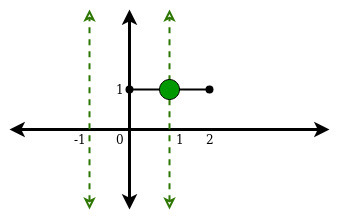
示例:查找函数f(x)= x 2的域和范围,其中-1
解决方案:
As given in the example, x has a restriction from -1 to 1, so the domain of the function in the interval form is (-1,1).
域值是横坐标,并且f是x的函数,因此,通过将横坐标的值获得的f(纵坐标)的值将成为我们的范围。很难为每个x手动找到y的值,因此如果我们绘制图形并找到函数的范围(输出),将很容易。
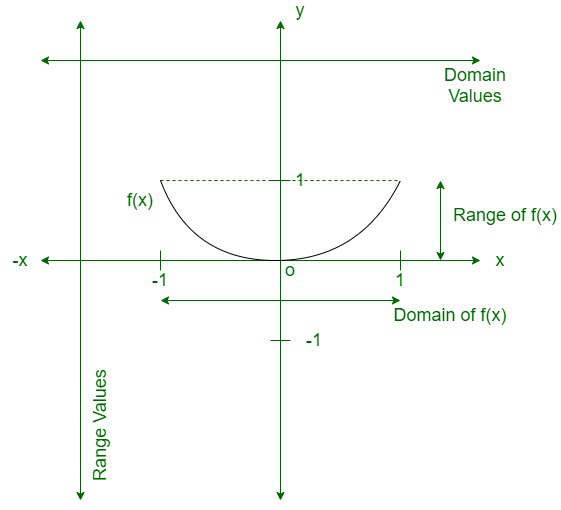
我们知道对于包含0且不包括1的函数,输出是正值。从图中可以得出结论,该函数在区间形式中的范围为[0,1)。
Note: As the value of x for which we get 1 as output is not included in the domain, So, we do not include 1 in the range.
We din’t use ‘[‘ or ‘]’ brackets in domain as -1 and 1 are not included for the value of x. And we used ‘[‘ for 0 as it is included in the values of range.
什么是共同域?
元素可能作为输出出现的Set称为Co-domain。
The elements which are the output value by giving input into function forms a set called Range.
All elements which are possible as output but not the outcome of function and range elements together makes a set called Co-domain.
示例:给定一个函数y = 2x,如果x> = 1,x <= 7则给定。
Then, Set A = { 1,2,3,4,5,6,7} is domain,
Set B = {2,4,6,8,10,12,14} is range,
Set C = { 1,2,4,6,7,8,10,12,14,15} or {all real numbers} is Co-domain.
共域的重要性
平方根是函数吗?不,因为当我们将16作为输入时,我们得到4,-4作为输出。
我们知道函数是单值的,我们不能从一个输入中获得两个值。但是,如果我们将共域定义为所有正整数,则范围将限于正整数。
因此,只有4个被视为输出。因此,如果定义或限制了共同域,则平方根将是一个函数。
共同域会影响给定关系是否为函数。
图上的关系和函数
众所周知,x坐标是域,y坐标是范围,那么对于任何x值,只允许y的一个值,然后仅将曲线或关系视为函数。
Vertical line test to check for functions: If any vertical line can meet the outline of a relation in only ONE point then the connection is called as a function.
If any vertical line intersect any graph of a relation at more than one value, then that relation can not be said as a function.
Here in the below figure, the line (y=c),where c is any constant is a function as any vertical line can intersect the horizontal line at only one point.
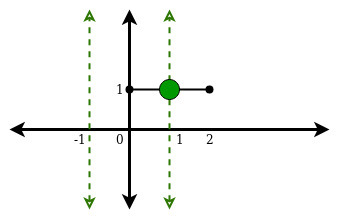
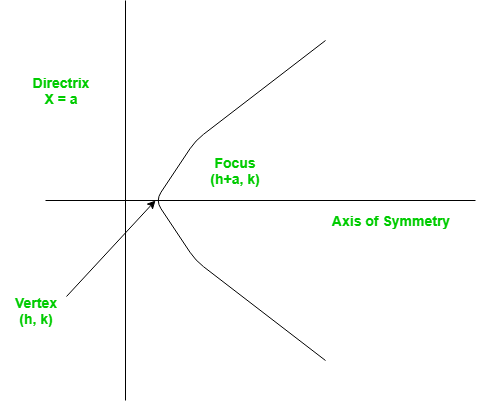
抛物线的该图不视为函数,因为垂直线在两个点处与该图相交。
关系类型
- 普遍关系
- 空关系
- 身份关系
- 对称关系
- 逆关系
- 自反关系
- 传递关系
普遍关系:
A relation is called as an universal connection if each component of a set is identified with one another.
Consider set A = {a, b, c}. The universal relations will be R if R = {m, n} where, |m-n| ≥ 0.
空关系:
The relation wherein there is no connection between any components of a set. An empty relation is also called void relation.
Consider if set A = {2, 3} then, void relation is R = {m,n} where, |m-n| = 8.
身份关系:
The relation where each component of a set is identified with itself
Consider a set A = {1,2,3}, the identity relation will be I = {1,1}, {2,2}, {3,3}. I = {(m,m), m ∈ A}
对称关系:
A relation is symmetric if a=b holds true then b=a also holds true. A connection R is symmetric just if (b, a) ∈ R is genuine when (a,b) ∈ R.
R = {(1, 2), (2, 1)} is symmetric relation set for a set A = {1, 2}.
逆关系:
Inverse relation occurs when a set has inverse pairs of another set.
Consider if set A = {(1,2),(3,4)}, then inverse relation will be R-1 = {(2,1), (4,3)}. R-1 = {(n, m): (m, n) ∈ R}
自反关系:
A relation where each component find itself.
For set A = {-1, 4}. Reflexive relation = R = {(-1, -1), (4, 4), (-1, 4), (4, -1)}. (x,x) ∈ R
传递关系:
If (m,n) ∈ R, (n,p) ∈ R, then (m,p) ∈ R.
Consider aRb and bRc ⇒ aRc ∀ a, b, c ∈ A